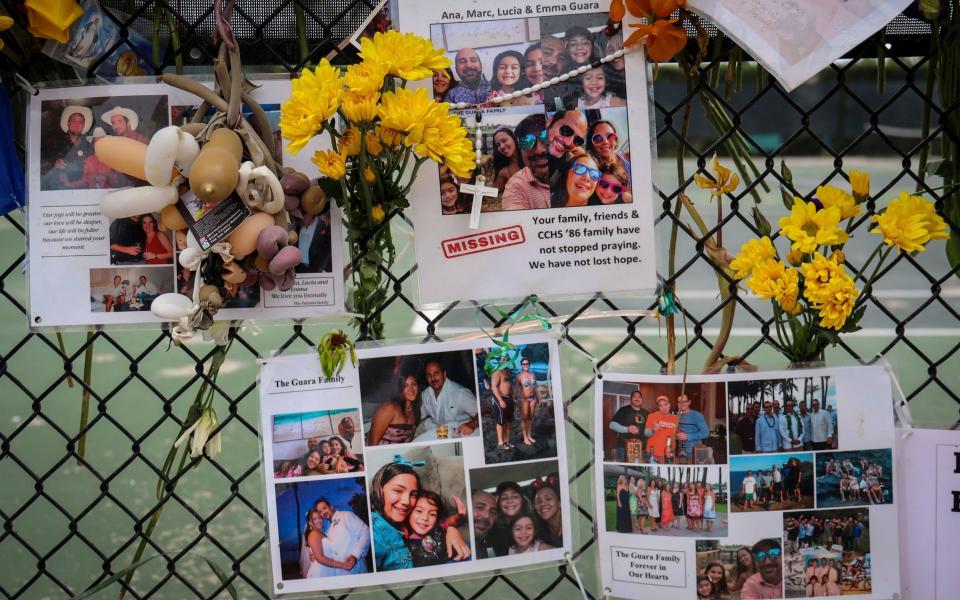Miami building collapse: No sign of final missing person as search formally ends

The search for human remains at the site of the collapsed Miami tower block has ended – with just one person still unaccounted for.
The Miami-Dade County fire and rescue department on Friday concluded a month of painstaking, round-the-clock work looking through what was left of the 12-storey oceanside Champlain Towers South after it crumpled on June 24, killing 97 people.
The site in the Miami suburb of Surfside has been mostly swept flat and the rubble moved to a warehouse.
Forensic scientists there are still at work, examining bags of debris for further human remains and personal effects, but there are now believed to be no more bodies to be found where the building once stood.
"At this step in the recovery process it has become increasingly challenging to identify victims, and we are relying heavily on the work of the medical examiner's office and the scientific, technical process of identifying human remains," Miami-Dade Mayor Daniella Levine Cava said in a statement.
She hailed members of the search and recovery teams as "true superheroes."
County officials said in a statement that the confirmed death toll stands at 97. One of those died while hospitalised, and the other 96 victims were recovered from the wreckage of the building, which collapsed at 1:30am local time as residents slept.
The dead included members of the area's large Orthodox Jewish community, the sister of Paraguay's first lady, her family and their nanny, as well as a local salesman, his wife and their two young daughters.
However, one more person remains unaccounted for - Estelle Hedaya, an outgoing 54-year-old who loved to travel and was fond of striking up conversations with strangers.
Officials have declined to clarify whether they have one additional set of human remains in hand that pathologists are struggling to identify or whether a search for that final set of remains continues.

If found, would bring the death toll to 98.
Hedaya’s younger brother Ikey has given DNA samples and visited the site twice to see the search efforts for himself.
"As we enter month two alone, without any other families, we feel helpless," he told The Associated Press on Friday. He said he gets frequent updates from the medical examiner's office.
Leah Sutton, who knew Hedaya since birth and considered herself a second mother to her, is worried that she will be forgotten.
"They seem to be packing up and congratulating everyone on a job well done. And yes, they deserve all the accolades, but after they find Estelle."
Except during the early hours after the collapse, survivors never emerged and crews found no evidence that anyone who was found dead had survived the initial collapse, said Fire Chief Alan Cominsky.
Search teams spent weeks battling the hazards of the rubble, including an unstable portion of the building that teetered above, a recurring fire and Florida's stifling summer heat and thunderstorms.
Authorities formally gave up hope of finding any survivors on July 7, two weeks after the building first collapsed.
They continued to go through a total of more than 14,000 tons of broken concrete and rebar, often working boulder by boulder, rock by rock, before finally declaring the mission complete.
"Providing closure to families was the ultimate test of everybody here," Scott Dean, leader of one of the two search task forces that worked 12-hour shifts while camping out at the site.
"I couldn't be prouder of the men and women that represent Miami-Dade Fire Rescue,” said Mr Cominsky.
The ultimate fate of the property where the building once stood has yet to be determined.

A judge presiding over several lawsuits filed in the collapse aftermath wants the property sold at market rates, which would bring in an estimated $100 million or more. Some condo owners want to rebuild, and others say a memorial should be erected to remember the dead.
"All options are on the table," Miami-Dade Circuit Judge Michael Hanzman said at a hearing this week.
Investigators have yet to determine what caused about half of the 136-unit high rise to cave in on itself, becoming one of the deadliest building collapses in US history.
The portion of the structure that was left standing, but unstable, was deliberately demolished about 10 days later.
Shortly after the disaster, it became clear that warnings about Champlain Towers South, which opened in 1981, had gone unheeded.
A 2018 engineering report detailed cracked and degraded concrete support beams in the underground parking garage and other problems that would cost nearly $10 million to fix.
The repairs did not happen, and the estimate grew to $15 million this year as the owners of the building's 136 units and its governing condo board squabbled over the cost, especially after a Surfside town inspector told them the building was safe.
A complete collapse was all but impossible to imagine. As many officials said in the catastrophe's first days, buildings of that size do not just collapse in the US outside of a terrorist attack. Even tornadoes, hurricanes and earthquakes rarely bring them down.
The disaster has prompted officials across South Florida to study residential buildings for signs of poor construction or structural weaknesses.

